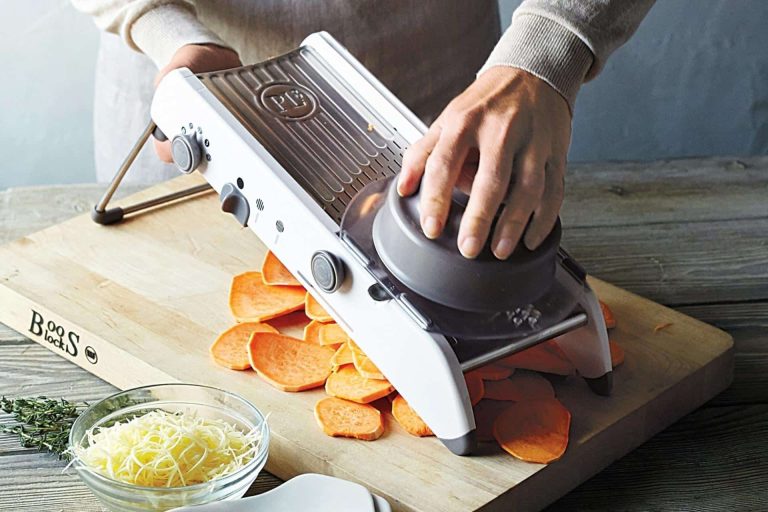Are you ready to elevate your culinary skills but feel a bit intimidated by the mandoline slicer? You’re not alone.
This handy kitchen tool can transform your cooking game, making slicing and dicing a breeze. But, without proper handling, it can be quite dangerous. Your safety is paramount, and understanding how to use a mandoline correctly is crucial. Imagine impressing your friends with perfectly sliced veggies, feeling confident and in control.
In this guide, we’ll share simple yet effective safety tips that will allow you to use your mandoline like a pro. Stick around to discover how you can enjoy the benefits of this versatile tool while keeping your fingers safe and sound.
Choosing The Right Mandoline
Choosing the right mandoline can make all the difference in your kitchen adventures. A mandoline is a powerful tool that can speed up prep time and give your dishes a professional touch. But with so many options available, how do you pick the perfect one for your needs?
Types Of Mandolines
Mandolines come in various types, each suited for different tasks. Flat mandolines are great for straightforward slicing tasks, while V-shaped mandolines offer more versatility with angled blades that handle a wider range of produce. You might prefer a julienne mandoline if you love making matchstick veggies or curly fries. Consider what you often cook. If salads are your thing, a flat mandoline might be ideal. Are you a fan of veggie chips? A V-shaped mandoline could be your best bet.
Blade Materials
Blade material is crucial for performance and durability. Stainless steel blades are robust and resist rust, making them a popular choice for regular use. Carbon steel blades offer sharpness but require more care to prevent rust. Ceramic blades are non-corrosive and great for precision slicing, though they can chip if mishandled. Think about how often you’ll use your mandoline. If you’re cooking daily, stainless steel is reliable and low maintenance. For occasional use, ceramic can provide excellent results without worrying about rust.
Consider your kitchen habits and preferences when choosing a mandoline. Do you often cook in a rush, or do you savor the preparation process? The right mandoline can enhance your cooking experience, making meal prep both efficient and enjoyable.
Have you ever chosen a kitchen tool just because it looked cool, only to find it wasn’t the best fit for your needs? With mandolines, choosing the right one can save you time and frustration. Remember, it’s not just about the blade; it’s about how you cook and what you cook.

Credit: www.tiktok.com
Setting Up Safely
Ensure safe slicing with mandoline safety tips for beginners. Use a guard to protect fingers from sharp blades. Keep the mandoline stable on a clean, dry surface to prevent slipping.
Setting up your mandoline safely is crucial for beginners. A well-prepared setup can prevent accidents and enhance your slicing experience. By following a few simple steps, you can ensure a safer slicing process. Let’s explore how to set up your mandoline properly.Proper Assembly
Assemble your mandoline with care. Start by reading the instruction manual thoroughly. Each model may have specific assembly steps. Ensure all parts fit securely. Loose parts can cause slips or cuts. Check the blade is sharp and positioned correctly. A dull or misaligned blade can lead to uneven cuts. Always handle the blade with caution.Secure Placement
Place your mandoline on a stable surface. A non-slip mat or damp cloth underneath can help. This prevents the mandoline from moving during use. Check the surface for stability. Wobbly surfaces increase the risk of accidents. Ensure the mandoline’s feet are gripping the surface well. This ensures it stays in place while you slice.Using Protective Gear
Using a mandoline can be risky without the right protective gear. Beginners often face cuts and injuries. Proper equipment can help prevent these accidents. Safety should be a top priority when handling sharp tools. Protective gear ensures a safer cooking experience. Let’s explore essential gear for mandoline safety.
Cut-resistant Gloves
Cut-resistant gloves are vital for mandoline safety. They shield your fingers from sharp blades. Choose gloves made from strong materials like Kevlar. They provide a sturdy barrier against cuts. Ensure the gloves fit snugly. Loose gloves might slip and offer less protection. Always wear them before you start slicing.
Food Holder
A food holder is another essential tool. It grips the food securely during slicing. This keeps your hands away from the blade. Many mandolines come with built-in food holders. If yours doesn’t, consider buying one separately. A good holder will have spikes or grips. These help to hold the food firmly in place. Ensure the holder is clean and dry before use. This prevents slips and ensures a smooth slicing process.

Credit: www.amazon.com
Handling Techniques
Using a mandoline can be intimidating for beginners. Mastering handling techniques ensures safety and efficiency. Proper handling prevents accidents and produces perfect slices. Focus on grip and pressure for optimal results.
Correct Grip
Holding the mandoline correctly is crucial. Use your dominant hand to stabilize the tool. Place your other hand on the food holder. Keep fingers away from the blade. A firm grip ensures control during slicing.
Position your thumb securely. It helps maintain balance and prevents slipping. Use the palm for additional support. This technique reduces the risk of accidents.
Consistent Pressure
Apply steady pressure for even slices. Avoid pressing too hard. Gentle force ensures smooth cutting. Sudden pressure changes can lead to uneven slices.
Begin with light pressure. Gradually increase if needed. This technique helps maintain consistency. It also protects the blade from damage.
Maintaining Focus
Stay focused while using a mandoline to ensure safety. Keep your eyes on the slicer and your fingers safe. Use the guard provided to protect your hands and slice consistently.
Maintaining focus while using a mandoline slicer is crucial for your safety. It’s easy to be distracted or lose concentration, especially if you’re multitasking in the kitchen. However, keeping your mind on the task at hand can prevent accidents and ensure you slice your ingredients perfectly. Let’s dive into some practical tips to help you stay focused and safe.Avoid Distractions
Distractions are everywhere in the kitchen. Whether it’s your phone buzzing or someone talking to you, they can easily take your attention away from the slicer. Consider setting your phone to silent mode or moving it to another room. This simple action removes one common distraction. If you’re preparing a meal with family or friends around, ask for a few quiet minutes to finish slicing. Explain the importance of your focus for safety.Mindful Slicing
Mindful slicing is all about being aware of each movement. It requires your full attention on the slicer and the food you are cutting. Before you start, visualize the slicing process in your mind. This mental preparation can sharpen your focus. As you slice, pay attention to the texture and feel of the food. Notice how each slice feels under the blade. This can make the task more engaging and less monotonous. A friend once told me that counting each slice helped them maintain their focus. It turns slicing into a kind of meditative practice. Could this approach work for you? It’s worth trying if you often find your mind wandering. By maintaining focus, you protect yourself from accidents and achieve better results with your mandoline slicer. What other strategies do you think could help you stay focused in the kitchen?Cleaning And Storing
Cleaning and storing a mandoline safely is crucial for beginners. Always dry the blade thoroughly to prevent rust. Store it in a secure place, away from reach of children, to avoid accidents.
Cleaning and storing your mandoline properly is crucial for safety and longevity. Mandolines can be intimidating because of their sharp blades, but with a few simple steps, you can keep them in top condition while ensuring your safety. Whether you’re a beginner or just someone who wants to keep their kitchen tools in pristine shape, these tips will help you handle your mandoline with confidence and ease. ###Safe Cleaning Methods
After using your mandoline, resist the urge to leave it soaking in the sink. Water can dull the blades and increase the risk of rust. Instead, use a soft-bristled brush to gently remove food particles. This keeps your fingers away from the sharp edges. Consider using mild dish soap and warm water. Avoid anything too abrasive, as it could damage the mandoline’s surface. A microfiber cloth is great for drying, ensuring no moisture remains. Have you ever cut yourself on a kitchen tool because it wasn’t cleaned properly? By keeping your mandoline clean, you reduce the chance of accidental cuts from leftover food residue. ###Proper Storage
Storing your mandoline safely is just as important as cleaning it. You don’t want it hidden away where you might accidentally grab the wrong end. Use a protective sleeve if your mandoline came with one. It shields the blade and keeps it safe from other kitchen tools. Designate a spot in your kitchen drawer or cabinet specifically for your mandoline. This way, you always know where it is, and it’s less likely to get damaged. Consider a storage solution where the blade side is facing down or away from you. Imagine reaching for a tool in your drawer and nicking your finger on a loose blade. Proper storage prevents such accidents and keeps your kitchen organized. Do you have a habit of tossing kitchen tools into drawers without thought? Rethink this approach for your mandoline, ensuring it remains a reliable kitchen companion.Practicing Regularly
Using a mandoline slicer can be intimidating for beginners. Regular practice helps improve your skills and makes the tool easier to use. Handling a mandoline with confidence is crucial for safety. Practice allows you to become familiar with the slicer’s features and functions. Over time, you’ll understand the proper grip and slicing techniques. The more you use it, the less scary it feels.
Developing Confidence
Confidence comes from familiarity. Practice lets you become comfortable with the mandoline. Start by slicing soft vegetables like cucumbers. Feel the blade’s movement and adjust your grip accordingly. Gradually move to harder vegetables, building your confidence. As you practice, you’ll notice less hesitation. Confidence reduces the risk of accidents. You feel more in control, making safer slices.
Improving Technique
Technique improves with regular practice. Focus on consistent pressure when slicing. This helps achieve even slices and reduces waste. Practice also helps with speed, making cooking quicker. Watch your hand placement to avoid cuts. Repetition trains your muscle memory, enhancing your technique. Each practice session refines your skills. Over time, slicing becomes second nature.

Credit: www.sandiegouniontribune.com
Common Mistakes To Avoid
Mandolines are fantastic tools for slicing fruits and vegetables quickly. Yet, they can be dangerous if not used correctly. Beginners often make common mistakes that lead to accidents. Understanding these mistakes can enhance your safety and efficiency.
Overconfidence
Many beginners feel confident after a few successful slices. This overconfidence can lead to carelessness. You might rush through tasks without paying attention. Keep your focus sharp. Always handle the mandoline with caution.
Remember, even experts take their time. The blade is extremely sharp. Even a small distraction can lead to injuries. Stay alert and work slowly. Your fingers are worth the extra effort.
Ignoring Safety Features
Mandolines come with safety features for a reason. Many beginners ignore these features, thinking they are unnecessary. This is a mistake. Use the hand guard provided with your mandoline. It protects your fingers from the blade.
Read the manual to understand all safety features. Some mandolines have adjustable settings. These settings can help you achieve the perfect slice without risking injury. Always check that these features are in place before you start slicing.
Ignoring safety features is risky. Respect the design and use all precautions. Your safety should always come first.
Frequently Asked Questions
How To Use A Mandoline Slicer Safely?
Use a mandoline slicer with caution. Always use the hand guard for protection. Keep fingers clear of the blade. Slice slowly and steadily to avoid accidents. Clean the slicer carefully after use. Store safely in a secure place.
What Are Two Safety Considerations You Need To Be Aware Of When Using A Mandoline?
Use a hand guard to protect fingers from the blade. Ensure the mandoline is stable to prevent slips.
What Must You Always Have When Using A Mandolin?
Always use a cut-resistant glove when using a mandolin. It protects your hand from accidental cuts. Ensure the mandolin is stable and use the safety guard for added protection. Keep fingers away from the blade and focus on the task to avoid injuries.
Safety is crucial when slicing with a mandolin.
How To Not Cut Yourself On A Mandolin?
Use a protective glove or guard to prevent cuts. Keep fingers away from the blade. Slice slowly and maintain focus. Adjust the mandolin to the correct thickness. Ensure the mandolin is stable on the surface.
Conclusion
Stay safe while using your mandoline. Practice makes perfect. Always use the hand guard. Keep your focus sharp. Maintain clean and dry hands. Avoid distractions in the kitchen. Regularly check your mandoline’s blade. Replace if dull. Enjoy slicing with confidence.
Safety first, always! Follow these tips for a smooth experience. Cooking should be fun, not dangerous. Happy slicing!


